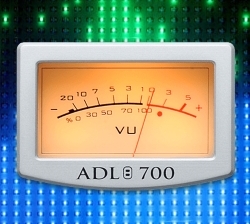
Digital Metering
A digital meter—which is not a VU meter—has a scale with 0 dB all the way at the top. (Shown below is the Selected Channel level meter from a PreSonus StudioLive 32.4.2AI digital mixer.)
This doesn’t represent a specific analog voltage level but rather represents maximum digital level – a sample represented by a binary number with all the significant bits turned on.
Digital meters (regardless of what the scale says) measure dB relative to the maximum value (“full scale”) rather than a nominal value, as with an analog or standard VU meter. We call this dBFS, where the all-bits-on value is represented by 0 dBFS.
Unlike the VU meter, with a digital meter there is no headroom above 0. You can’t turn on more bits than the system’s word length. It’s up to you, the engineer, to decide where to set the analog-to-digital converter’s input gain to allow as much headroom as you’d like.
The object is to leave enough analog room so that only the loudest peaks approach a digital level of 0 dBFS. While today’s digital systems typically accommodate internal processing that yields a word length greater than what goes in or comes out, a 24-bit analog-to-digital converter is flat out when that 24th bit is turned on.
Perceived loudness is the same whether the source is analog or digital but we view headroom and operating range differently in the two worlds.
But How Loud is It?
Loudness is a function of both the recorded level and how far the listener has the volume turned up. In the past few years, commercial (and following in their footsteps, independently produced) recordings have been in a race to make each recording sound louder, when played at the same volume setting, than the previous one. A whole segment of our industry has sprung up as a result.
K-System Metering
In a presentation at the October 1999 Audio Engineering Society convention, mastering engineer Bob Katz of Digital Domain described the concept of monitoring at a calibrated sound-pressure level. He proposed a new type of meter scale that essentially displays headroom relative to the calibrated monitoring SPL rather than the digital level. His meter scale looks like a VU meter in that it’s calibrated both above and below 0 VU, but unlike a VU meter, it has a linear scale.
The K-System, then, is an integrated metering system tied to monitoring gain, and it is intended to standardize the levels at which sound is mixed and mastered.

